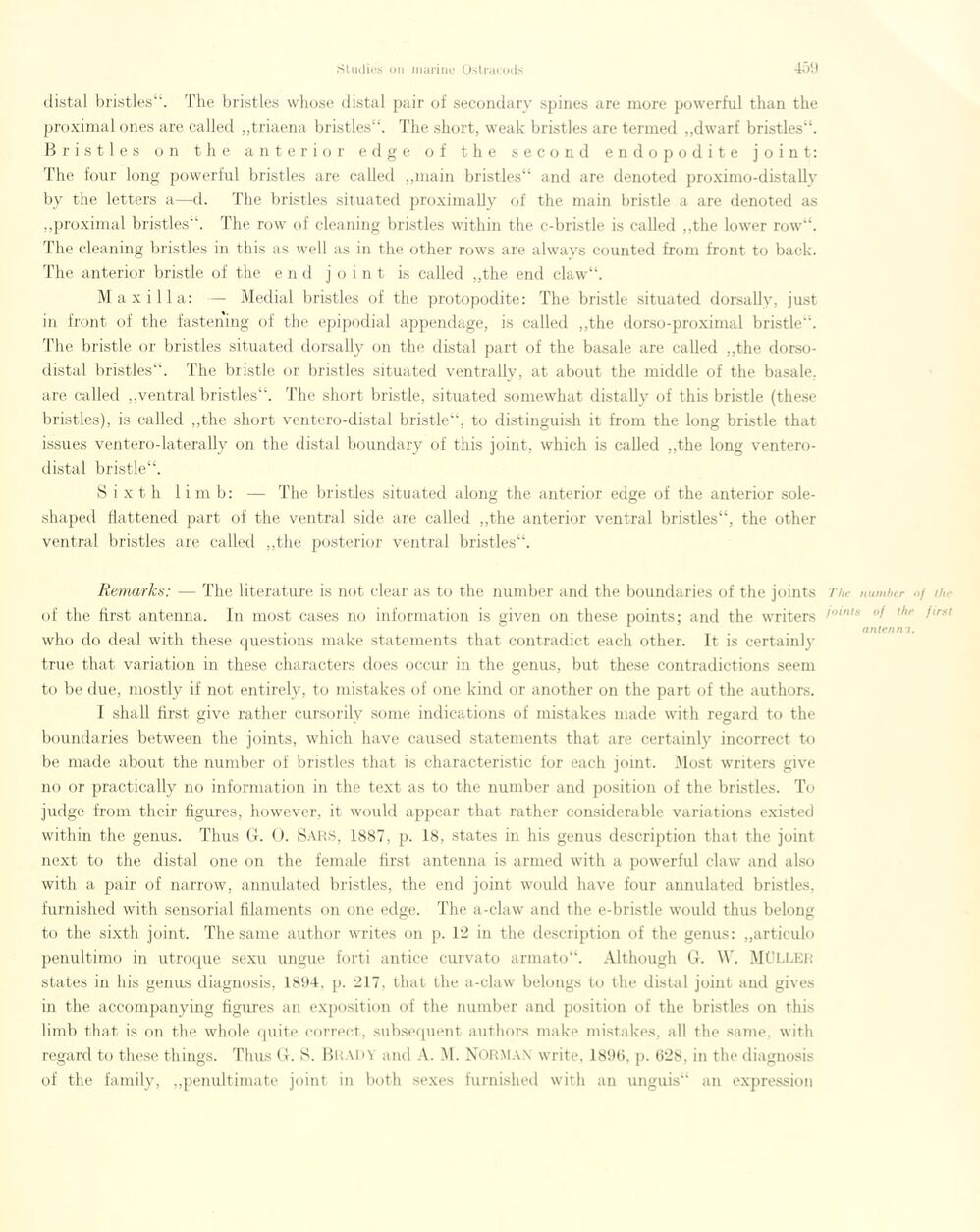
Full resolution (JPEG) - On this page / på denna sida - Sidor ...

<< prev. page << föreg. sida << >> nästa sida >> next page >>
Below is the raw OCR text
from the above scanned image.
Do you see an error? Proofread the page now!
Här nedan syns maskintolkade texten från faksimilbilden ovan.
Ser du något fel? Korrekturläs sidan nu!
This page has never been proofread. / Denna sida har aldrig korrekturlästs.
distal bristles“. The bristles whose distal pair of secondary spines are more powerful than the
proximal ones are called „triaena bristles“. The short, weak bristles are termed „dwarf bristles“.
Bristles on the anterior edge of the second en dop odite joint:
The four long powerful bristles are called „main bristles“ and are denoted proximo-distally
by the letters a—d. The bristles situated proximally of the main bristle a are denoted as
„proximal bristles“. The row of cleaning bristles within the c-bristle is called „the lower row“.
The cleaning bristles in this as well as in the other rows are always counted from front to back.
The anterior bristle of the end joint is called „the end claw“.
Maxilla: — Medial bristles of the protopodite: The bristle situated dorsally, just
in front of the fastening of the epipodial appendage, is called „the dorso-proximal bristle“.
The bristle or bristles situated dorsally on the distal part of the basale are called „the
dorso-distal bristles“. The bristle or bristles situated ventrallv, at about the middle of the basale,
are called „ventral bristles“. The short bristle, situated somewhat distally of this bristle (these
bristles), is called „the short ventero-distal bristle“, to distinguish it from the long bristle that
issues ventero-laterally on the distal boundary of this joint, which is called „the long
ventero-distal bristle“.
S i X t h limb: — The bristles situated along the anterior edge of the anterior
sole-shaped fiattened part of the ventral side are called „the anterior ventral bristles“, the other
ventral bristles are called „the posterior ventral bristles“.
Remarks: — The literature is not clear as to the number and the boundaries of the joints 77« i,umher «/ il,
of the first antenna. In most cases no information is given on these points; and the writers /0""’ °f 1
who do deal with these questions make statements that contradict each other. It is certainly
true that variation in these characters does occur in the genus, but these contradictions seem
to be due, mostly if not entirely, to mistakes of one kind or another on the part of the authors.
I shall first give rather cursorily some indications of mistakes made with regard to the
boundaries between the joints, which have caused statements that are certainly incorrect to
be made about the number of bristles that is characteristic for each joint. Most writers give
no or practically no information in the text as to the number and position of the bristles. To
judge from their figures, however, it would appear that rather considérable variations existed
within the genus. Thus G. O. SARS, 1887, p. 18, states in his genus description that the joint
next to the distal one on the female first antenna is armed with a powerful claw and also
with a pair of narrow, annulated bristles, the end joint would have four annulated bristles,
furnished with sensorial filaments on one edge. The a-claw and the e-bristle would thus belong
to the sixth joint. The same author writes on p. 12 in the description of the genus: „articulo
penultimo in utroque sexu ungue forti antice curvato armato“. Although G. \\r. MULLER
states in his genus diagnosis, 1894, p. 217, that the a-claw belongs to the distal joint and gives
in the accompanying figures an exposition of the number and position of the bristles on this
limb that is on the whole quite correct, subséquent authors make mistakes, all the same, with
regard to these things. Thus G. S. Brad\ and A. M. Norman write. 1896, p. 628, in the diagnosis
of the family, „penultimate joint in both sexes furnished with an unguis“ an expression
<< prev. page << föreg. sida << >> nästa sida >> next page >>